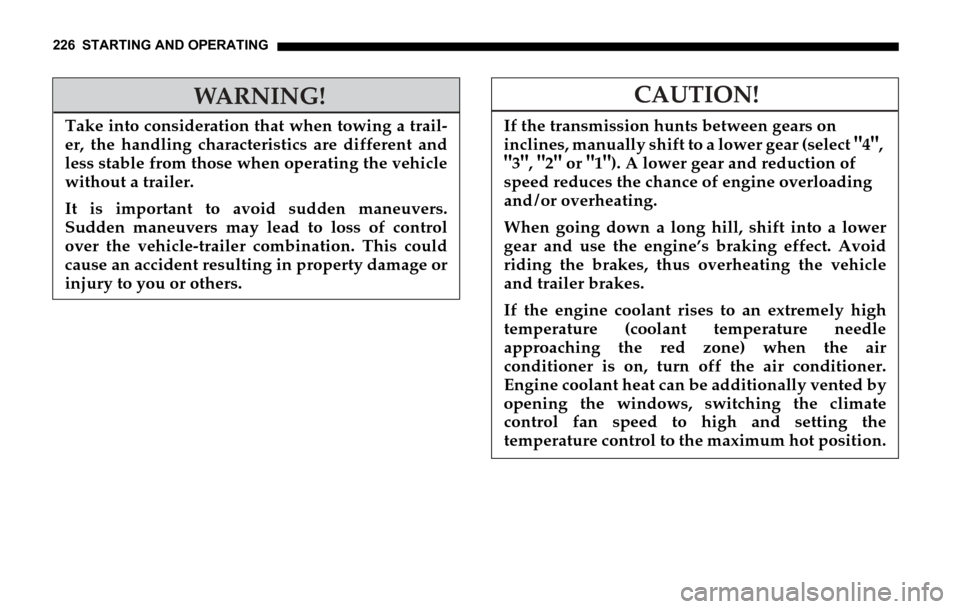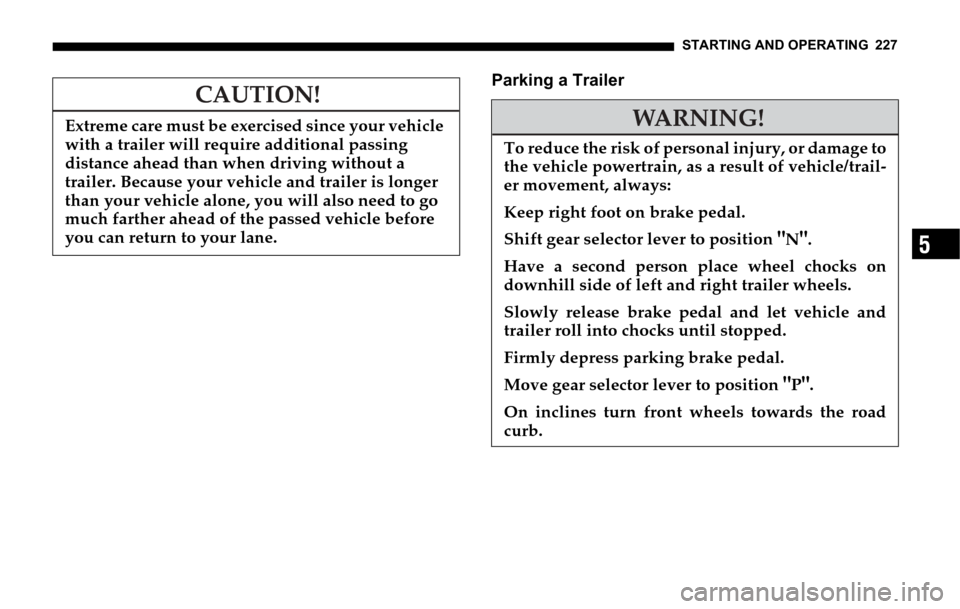DODGE SPRINTER 2006 1.G Owners Manual
Manufacturer: DODGE, Model Year: 2006, Model line: SPRINTER, Model: DODGE SPRINTER 2006 1.GPages: 330, PDF Size: 10.82 MB
Page 221 of 330

STARTING AND OPERATING 221
5
Certification Label
Even after careful determination of the combined
weight of all occupants, cargo and the trailer tongue
load (if applicable) as to not exceed the permissible
load limit, you must make sure that your vehicle never
exceeds the Gross VehicleWeight Rating (GVWR) and
the Gross Axle Weight Rating (GAWR) for either the
front or rear axle.
Under a maximum loaded vehicle condition, gross axle
weight ratings (GAWR’s) for the front and rear axles
must not be exceeded.
To determine the maximum loading conditions of your
vehicle, locate the statement "The combined weight of
occupants and cargo should never exceed XXX kg or
XXX lbs." on the Tire and Loading Information placard.
The combined weight of occupants, cargo/luggage
and trailer tongue weight (if applicable) should never
exceed the weight referenced here.
You can obtain the GVWR and GAWR from the
Certification label. The Certification Label can be
found below the driver’s seat on an outward facing
position of the mounting pillar. For more information on the trailer tongue load, refer
to "Trailer Tongue Load".
TRAILER TOWING
WARNING!
Failure to use proper equipment and driving tech-
nique can result in a loss of vehicle control when
towing a trailer.
Improper towing or failure to follow the
instructions contained in this guide can result in
serious injury. Follow the guidelines below
carefully to assure safe trailer operation.
Ask your authorized Sprinter Dealer, if you
require an explanation of information contained
in this guide.
Page 222 of 330

222 STARTING AND OPERATING
Trailer Hitches (Optional)
Only install a trailer hitch receiver approved for your
vehicle. For information on availability and
installation, please see your authorized Sprinter
Dealer.
The bumpers on your vehicle are not designed for use
with clamp-type hitches. Do not attach rental hitches
or other bumper-type hitches to them.
To reduce the possibility of damage, remove the hitch
ball adaptor from the receiver when not in use.
Electrical Connections (Optional)
The Sprinter is available with a variety of pre-installed
conditions (lines and turn signal indicator and brake
module installed and / or not installed). Make sure that
the correct trailer hitch receiver kit is used. For further
information, please see your authorized Sprinter
Dealer.
In order to prevent possible damage to the vehicle’s
electrical system by incorrectly installing the trailer
wiring plug, we recommend having the harness
connected at an authorized Sprinter Dealer.Vehicle and Trailer Weights and Ratings
Gross Vehicle Weight Rating (GVWR) is the maximum
permissible vehicle weight:
8,550 lbs (3,878 kgs),
9,990 lbs (4,531 kgs) or 10,200 lbs (4,627 kgs).
NOTE: The weight of your Sprinter is indicated on the
type plate. For type plate, see Identification Labels.
Gross Vehicle Weight (GVW): comprises weight of
vehicle including fuel, tools, spare wheel, installed
accessories, passengers, cargo and trailer tongue. It
must never exceed the GVWR.
Gross Axle Weight Rating (GAWR) is the maximum
permissible axle weight:
Type GVWR GAWR (FA) GAWR (RA)
2500
C/HC /
SHC8,550 lbs
3,878 kgs3,860 lbs
(1,751 kgs)5,360 lbs
(2,431 kgs)
3500
C/HC /
SHC9,990 lbs
4,531 kgs3,860 lbs
(1,751 kgs)7,060 lbs
(3,202 kgs)
10,200 lbs
4,627 kgs3,860 lbs
(1,751 kgs)7,060 lbs
(3,202 kgs)
Page 223 of 330

STARTING AND OPERATING 223
5
Gross Trailer Weight (GTW) is the maximum
permissible trailer weight to be towed:
5,000 lbs. (2,260 kgs)
Trailer Tongue Weight Rating (TWR) is the maximum
permissible weight of the trailer tongue: 500 lbs. (225 kgs)
limit for Sprinter approved hitch receiver.
NOTE: The GVWR and GAWR of your vehicle is
indicated on the Certification Label.
Trailer Tongue Load
The tongue load (tongue weight at the hitch ball) of any
trailer is an important weight tomeasure because it
affects the load you can carry in your vehicle. If a trailer
is towed, the tongue load must be added to the weight
of all occupants riding and any cargo you are carrying
in the vehicle to prevent exceeding your Sprinter tow
vehicle’s rear GAWR. The tongue load typically is
between 10 % and 15 % of the trailer weight and
everything loaded in it.
For example, if the trailer tongue load equals 140 lbs.
and the determined available cargo/luggage and
trailer tongue weight equals 750 lbs., the amount of
available cargo and luggage load capacity is 610 lbs.
(750 – 140 = 610 lbs.)Loading a Trailer
When loading a trailer, you should observe that
neither the permissible GTW, nor the GVWR are
exceeded.
Maximum permissible values are listed on the safety
compliance certification labels for the vehicle and for
the trailer to be towed. The lowest value listed must be
selected when determining how the vehicle and trailer
are loaded.
Load the trailer in such a manner that it has a tongue
weight (TW) between 10% and 15% of the GTW.
The tongue weight at the hitch ball must be added to
the GVW to prevent exceeding your Sprinter tow
vehicle’s rear GAWR.
Page 224 of 330

224 STARTING AND OPERATING
Checking Weights of Vehicle and Trailer
To assure that the tow vehicle and trailer are in
compliance with the maximum permissible weight
limits, and to know the actual weights, have the loaded
vehicle-trailer combination (tow vehicle including
driver, passengers and cargo, trailer fully loaded)
weighed on a commercial scale.
Check the vehicle’s front and rear Gross Axle Weight
(GAW), the GTW and TW. The values as measured
must not be exceeded, according to the weight listed
under “Vehicle and trailer weight and ratings”.
Attaching a Trailer
Please observe maximum permitted trailer dimensions
(width and length).
Most states and all Canadian provinces require safety
chains between your tow vehicle and the trailer. The
chains should be crisscrossed under the trailer tongue.
They must be attached to the hitch receiver, and not to
the vehicle’s bumper or axle. Be sure to leave enough
slack in the chains to permit turning corners.
Most states and all Canadian provinces require a
separate brake system at various trailer weights.
WARNING!
Do not connect a trailer brake system (if trailer is
so equipped) directly to the vehicle’s hydraulic
brake system as your vehicle is equipped with an-
tilock brakes. If you do, neither the vehicle’s
brakes nor the trailer’s brakes will function prop-
erly. This could cause an accident resulting in
property damage, injury or death to you or others.
The provided vehicle electrical wiring harness for
trailer towing has a brake signal wire for hook-up
to a brake controller.
Most states and all Canadian provinces require a
break-away switch on trailers with a separate
brake system. The switch activates the trailer
brakes in the possible event that the trailer might
separate from the tow vehicle.
You should consider using a trailer sway control
system. For further information see your
authorized Sprinter Dealer.
Page 225 of 330

STARTING AND OPERATING 225
5
Towing a Trailer
There are many different laws, including speed limit
restrictions, having to do with trailer towing. Make
sure that your vehicle-trailer combination will be legal,
not only for where you reside, but also for where you
will be driving. A good source for this information can
be the police or local authorities.
Before you start driving with the trailer, check the
trailer hitch, break-away switch, safety chains,
electrical connections, lighting and tires. Also adjust
the mirrors to permit unobstructed view beyond rear
of trailer.
If the trailer has electric brakes, start your vehicle and
trailer moving slowly, and then apply only the trailer
brake controller by hand to be sure the brakes are
working properly.
When towing a trailer, check occasionally to be sure
that the load is secure, and that lighting and trailer
brakes (if so equipped) are functioning properly.
Always secure items in the trailer to prevent load shifts
while driving.Take into consideration that when towing a trailer, the
handling characteristics are different and less stable
from those when operating the vehicle without a
trailer. It is important to avoid sudden maneuvers. The
vehicle and trailer combination is heavier, and
therefore is limited in acceleration and climbing ability,
and requires longer stopping distances. It is more
prone to reacting to side wind gusts, and requires more
sensitive steering input.
In order to gain skill and an understanding of the
vehicle’s behavior, you should practice turning, stopping
and backing up in an area which is free from traffic.
If possible, do not brake abruptly, but rather engage
the brake slightly at first to permit the trailer to activate
its brake. Then increase the braking force.
Page 226 of 330

226 STARTING AND OPERATING
WARNING!
Take into consideration that when towing a trail-
er, the handling characteristics are different and
less stable from those when operating the vehicle
without a trailer.
It is important to avoid sudden maneuvers.
Sudden maneuvers may lead to loss of control
over the vehicle-trailer combination. This could
cause an accident resulting in property damage or
injury to you or others.
CAUTION!
If the transmission hunts between gears on
inclines, manually shift to a lower gear (select
"4",
"3", "2" or"1"). A lower gear and reduction of
speed reduces the chance of engine overloading
and / or overheating.
When going down a long hill, shift into a lower
gear and use the engine’s braking effect. Avoid
riding the brakes, thus overheating the vehicle
and trailer brakes.
If the engine coolant rises to an extremely high
temperature (coolant temperature needle
approaching the red zone) when the air
conditioner is on, turn off the air conditioner.
Engine coolant heat can be additionally vented by
opening the windows, switching the climate
control fan speed to high and setting the
temperature control to the maximum hot position.
Page 227 of 330

STARTING AND OPERATING 227
5
Parking a TrailerCAUTION!
Extreme care must be exercised since your vehicle
with a trailer will require additional passing
distance ahead than when driving without a
trailer. Because your vehicle and trailer is longer
than your vehicle alone, you will also need to go
much farther ahead of the passed vehicle before
you can return to your lane.WARNING!
To reduce the risk of personal injury, or damage to
the vehicle powertrain, as a result of vehicle/trail-
er movement, always:
Keep right foot on brake pedal.
Shift gear selector lever to position
"N".
Have a second person place wheel chocks on
downhill side of left and right trailer wheels.
Slowly release brake pedal and let vehicle and
trailer roll into chocks until stopped.
Firmly depress parking brake pedal.
Move gear selector lever to position
"P".
On inclines turn front wheels towards the road
curb.
Page 228 of 330

228 STARTING AND OPERATING
EMISSIONS CONTROL SYSTEM (CATALYTIC
CONVERTER)
INHALATION OF EXHAUST GASFORDING (WADING CAPABILITY)
Avoid fording flooded roads or passing through water
unless you are certain as to how deep it is. Driving
through deep water can cause damage to the vehicle,
including but not limited to the electrical components,
engine, transmission, etc. This type of damage is not
covered under the Warranty.
WARNING!
When driving or parking the vehicle, make sure
that its exhaust system does not come into contact
with flammable material (such as dry leaves) as
these materials may otherwise catch fire.
WARNING!
Inhalation of exhaust gas is hazardous to your
health. All exhaust gas contains carbon monoxide
and inhaling it can cause unconsciousness and
lead to death.
Do not run the engine in confined areas (such as a
garage) which are not properly ventilated. If you
think that exhaust gas fumes are entering the
vehicle while driving, have the cause determined
and corrected immediately. If you must drive
under these conditions, drive only with at least
o
ne window fully open.
Page 229 of 330

STARTING AND OPERATING 229
5
BODY BUILDER GUIDELINE
If you intend on making any alterations to the vehicle,
we strongly recommend that you select one of the
following options in order to obtain all necessary
information:
1. Contact the authorized Sprinter Dealer nearest you
to obtain a copy of the Sprinter Body Builder
Guideline.
2. Call DaimlerChrysler Vans LLC at telephone (800)
992-1997 to request a copy of the Sprinter Body
Builder Guideline (there may be a charge).
3. Write to the following address and order the
Sprinter Body Builder Guideline (there may be a
charge).
DaimlerChrysler Vans LLC
P.O. Box 21-8004
Auburn Hills, MI 48321-8004
United States of AmericaBody Builders and Dealers who makes any
modifications which may affect the final certification of
the engine, vehicle or equipment assume the sole
responsibility for the vehicle, including labeling and
documentation, affected by their modifications.
It is their responsibility to certify that the altered
vehicle conforms to all applicable standards and
regulations affected by the vehicle alteration or
continues to comply with the Motor Vehicle Safety
standards and Emissions regulations.
WARNING!
Any modifications or alterations of the Sprinter
vehicle not in compliance with the Sprinter Body
Builder Guideline and the Sprinter Operator’s
Manual may seriously inhibit its roadworthiness
and safety and may lead to an accident resulting in
serious personal injury or death. Consult the
Sprinter Body Builder Guideline and the Sprinter
Operator’s Manual prior to initiating any alter-
ations or modifications.
Page 230 of 330

230 STARTING AND OPERATING
They are responsible for ensuring that modifications or
equipment installation does not affect the safety of the
vehicle.
A Special Note Concerning Vehicle AlterationThe Manufacturer is not responsible for any final
certification or claims sounding in product liability, or
warranty claims, which result from any component,
assembly, or system being altered, or which cause non-
compliance with any of the emission control standards
or motor vehicle safety standards, or which would
otherwise cause the vehicle to be or become defective
or unsafe.
The Manufacturer does not assume the responsibility
as the final stage manufacturer or the consequential
product liability.
WARNING!
Any modifications or alterations of the Sprinter
vehicle not in compliance with the Sprinter Body
Builder Guideline and the Sprinter Operator’s
Manual may seriously inhibit its roadworthiness
and safety and may lead to an accident resulting in
serious personal injury or death. Consult the
Sprinter Body Builder Guideline and the Sprinter
Operator’s Manual prior to initiating any alter-
ations or modifications.